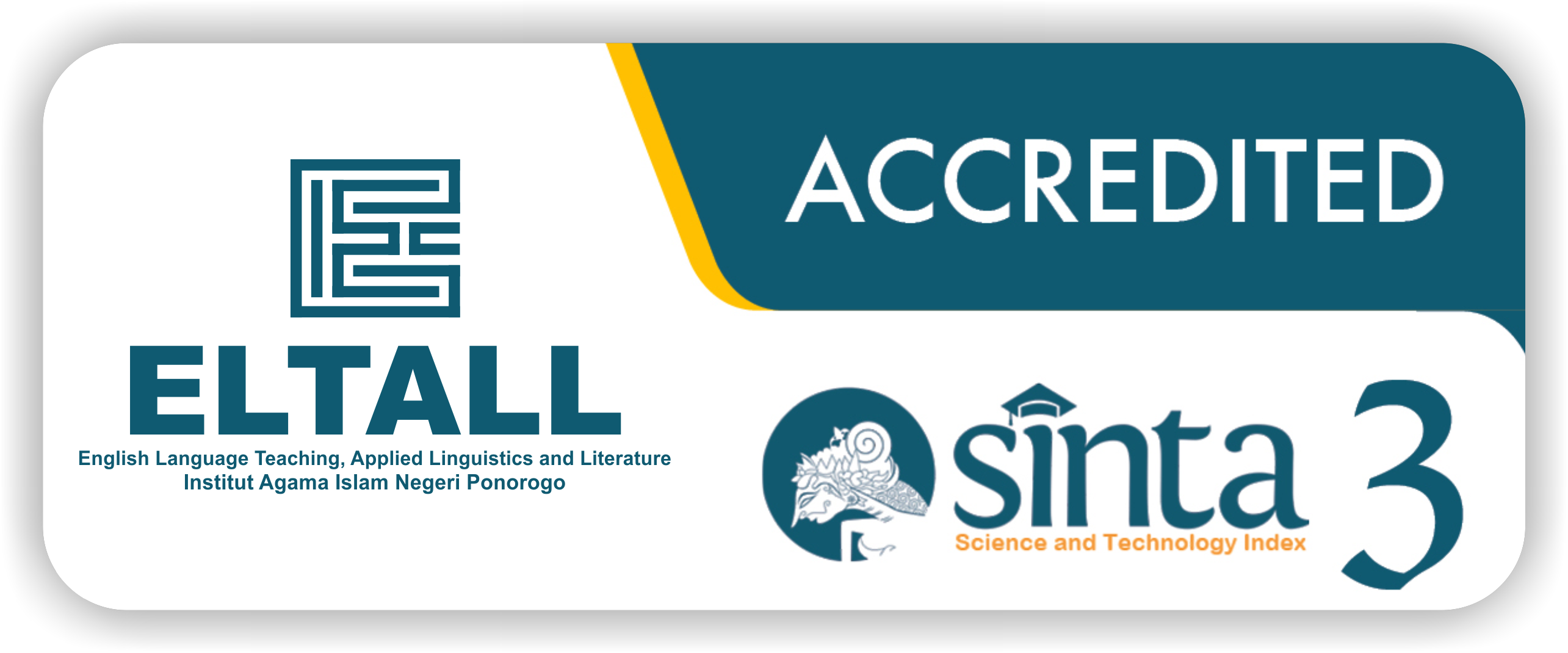The Effectiveness of Using Smalltalk2me AI in Teaching Speaking Skills
DOI:
https://doi.org/10.21154/eltall.v5i2.9146Keywords:
Smalltak2me, Artificial Intelligence (AI), Teaching SpeakingAbstract
The purpose of this study is to find out the effectiveness of using Smalltalk2me AI in teaching speaking skills to secondary students. This quantitative research implemented a one-group pretest-posttest pre-experimental design. The collection of data process consisted of three steps: pre-test, treatment, and post-test. Then the researchers found the results of students’ achievement after they were taught by using Smalltalk2me AI. This research used Microsoft Excel to analyze the data by looking for the mean, standard deviation, T-test value, and T-test table. The findings of this study revealed that the average of the post-test was higher than the average of the pretest (30,75>41). It means that this study discovered a significant or substantial difference between the pre-test and post-test scores for students who had been taught by using Smalltalk2me AI. Therefore, it is possible to infer that Smalltalk2me AI is an excellent tool to teach speaking skills since tenth-grade students at SMA 1 Sajingan could be more active in speaking with high accuracy and great fluency.
References
Brown, G. , & Yule, G. (1983). Discourse analysis.
Brown, H. D., & Heekyeong, L. (2015). teaching by principles:an interactive approach to language pedagogy, fourth edition (4th ed.). Pearson Education, Inc.
Creswell, J. W., & Creswell, J. D. (2018). Research Design Qualitative, Quantitative, and Mixed Methods Approaches (fifth). SAGE Publications.
Dayanand, Anupama. K. (2018). Hypothesis types and research. International Journal of Nursing Science Practice and Research.
Hughes, A. (2003). Testing For Language Teachers (Second edition).
Leedy, P. D., & Ormrod, J. E. (2015). Practical Research”¯: Planning and Design (J. W. Johnson & C. Griscom, Eds.; Eleventh Edition). Pearson Education.
Liya Umaroh, Mukaromah Mukaromah, & Muhammad Naufal. (2023). Enhancing Speaking Skill Through Ai-Powered Technology. Seminar Nasional Teknologi Dan Multidisiplin Ilmu (SEMNASTEKMU), 3(1), 142”“148. https://doi.org/10.51903/semnastekmu.v3i1.209
Patiung, D., Tolla, A., Anshari, A., & Dolla, A. (2015). The Study of Learning Speaking Skills Based on Communicative Approach. Journal of Language Teaching and Research, 6(5), 1093. https://doi.org/10.17507/jltr.0605.23
Safitriani, R. , & Jayadi, M. K. (2021). Teaching speaking book. Sanabil.
Thornbury, S. (2005). How to Teach Speaking. London: Longman.
Xiao, M., & Yi, H. (2021). Building an efficient artificial intelligence model for personalized training in colleges and universities. Computer Applications in Engineering Education, 29(2), 350”“358. https://doi.org/10.1002/cae.22235
Zou, B., Du, Y., Wang, Z., Chen, J., & Zhang, W. (2023). An Investigation Into Artificial Intelligence Speech Evaluation Programs With Automatic Feedback for Developing EFL Learners’ Speaking Skills. SAGE Open, 13(3). https://doi.org/10.1177/21582440231193818
Downloads
Published
Issue
Section
License
Copyright (c) 2024 ELTALL: English Language Teaching, Applied Linguistic and Literature

This work is licensed under a Creative Commons Attribution-NonCommercial 4.0 International License.
All articles published in ELTALL (English Language Teaching, Applied Linguistics, and Literature Journal) are licensed under the Creative Commons Attribution-NonCommercial 4.0 International License (CC BY-NC 4.0).
Under this license, authors and readers are free to:
- Share. copy and redistribute the material in any medium or format
- Adapt. remix, transform, and build upon the material
Under the following terms:
- Attribution. You must give appropriate credit, provide a link to the license, and indicate if changes were made. You may do so in any reasonable manner but not in any way that suggests the licensor endorses you or your use.
- Non-Commercial. You may not use the material for commercial purposes.
Notices:
- The licensor cannot revoke these freedoms as long as you follow the license terms.
- No additional restrictions. You may not apply legal terms or technological measures that legally restrict others from doing anything the license permits.
For the full legal code of the license, please visit: https://creativecommons.org/licenses/by-nc/4.0/













